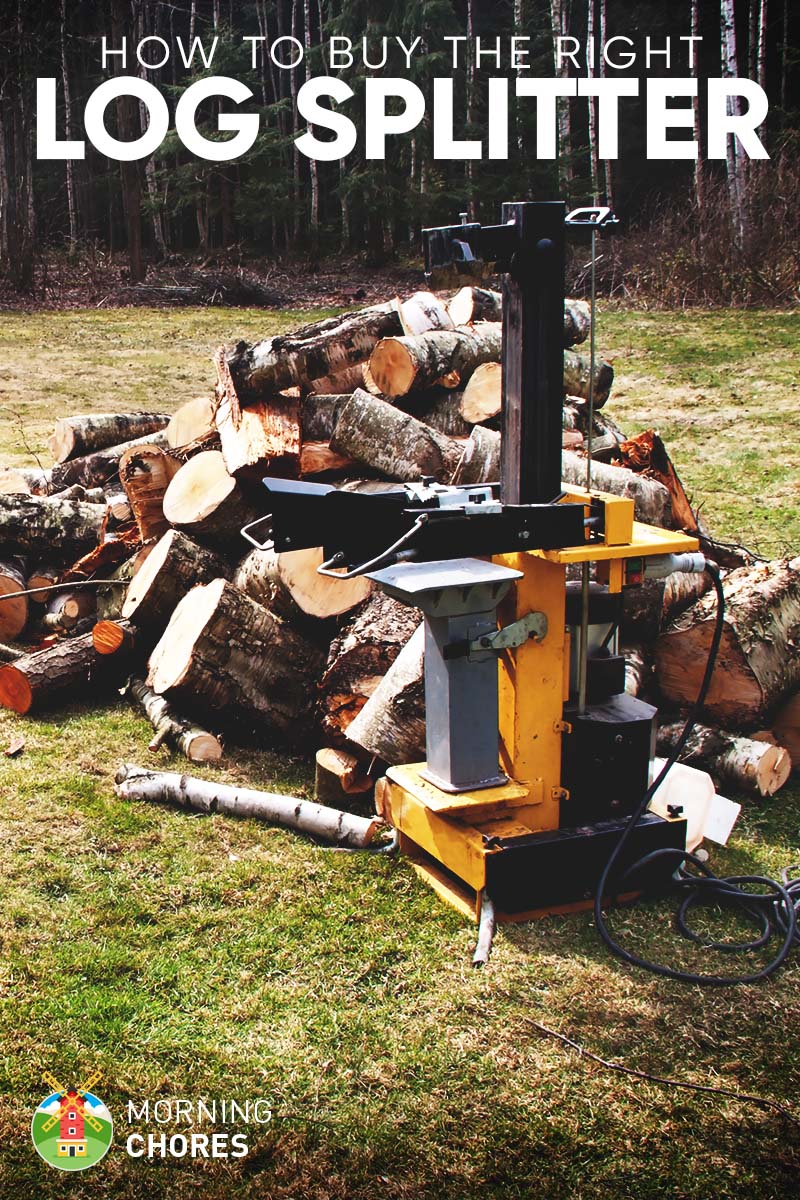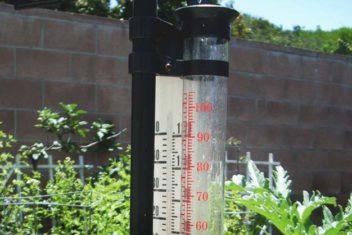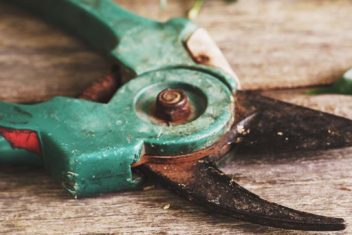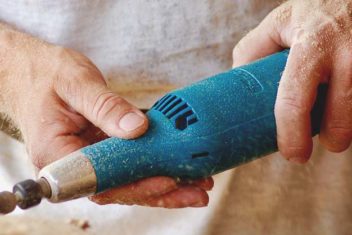As we leave the warm sunny days behind and the colder autumn and winter months begin to approach, we start to turn our thoughts to winter woolies, fluffy blankets, steaming cups of hot chocolate, and cozy log fires. But with log fire comes the daunting task of having to replenish the woodpile.
Fortunately, in these modern times, we do not have to resort to using an axe, which can be frustrating when it doesn’t land straight on target, and the head gets stuck in the wood. Using an axe is not only dangerous, but it is tiring and can put a lot of strain on your back.
If you would like a superior option to keep your home fully stocked with wood all through winter, then a wood or log splitter will power through those logs in no time.
The 7 Best Log Splitters
- Southland Outdoor Power Equipment Electric Log Splitter
- Boss Industrial Electric Log Splitter
- Champion Power Equipment Gas Log Splitter (Our Top Pick)
- NorthStar Horizontal/Vertical Log Splitter
- YARDMAX Horizontal/Vertical Log Splitter
- Sun Joe Hydraulic Log Splitter
- Logosol Smart-Splitter Log Splitter
Our Top Pick for the Best Log Splitter
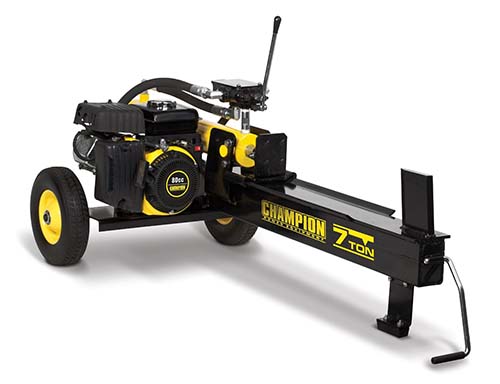
Our top pick for the best log splitter is the Champion Power Equipment Gas Log Splitter.
It is an efficient log splitter, which is capable of handling larger-sized logs up to 19-inches. It is affordable, fast, and lightweight, which means it can fit into the boot of most vehicles. Although it requires a fuel and oil mixture, the splitter is EPA+CARB certified in 50 States.
Check the price on AmazonHow to Choose a Log Splitter
Choosing a log splitter will depend on your wood-burning requirements; whether you have a domestic fireplace or a wood-burning stove. It can depend on the amount or size of the logs you will need, and whether you need to transport wood, like when you are going to a campsite.
Wood or log splitters come in all sizes, have different functions, and are powered by different energy sources. Some are compact, others are bulkier, and some models are portable and can be towed behind your vehicle or can be placed in the boot of a car. The 5 main types of log splitters are electric, gas, vertical, horizontal, and manual/hydraulic.
Before you head off to choose a log splitter there are a few things to consider.
1. Log Splitter Tonnage
One of the main things that you need to consider before you purchase a log splitter, is to consider how much log splitter tonnage you will need. Log splitter tonnage means the measurement of the amount of force that the splitter exerts on the log as it splits it.
The higher the tonnage, the more force it will exert onto your log, making it easier to cut through bigger and tougher logs. Log splitters that have lower tonnage ratings exert less force, but they are smaller machines and use less energy.
To be able to determine what level of tonnage you will need, will depend on the type of wood and diameter of the logs you will need to cut. The wider the size of the logs the higher the level of tonnage will be needed. If the wood is green then you will more likely need more tonnage, if the wood is dry you may need less.
If the wood is hardwood like from an oak or walnut tree then you will need more tonnage than if the wood is softer like from a pine tree.
For example: if the wood of the log is dry and the diameter is 6-inches the level of tonnage will be 4-tons. If the wood is fresh and the diameter is 24-inches, then you will need a log splitter that has 25-30 plus tonnage.
2. Automatic Ram Return
Another key feature is the Automatic Ram Return, which guarantees that the wood is cut faster. Speed is an important consideration to make when choosing electric log splitters, especially when you have a large load of wood to cut. The less time you spend cutting means more time spent in front of the fire.
3. Hardwood or Softwood
The best kind of wood that splits easily is the softer woods such as ash, birch, beech, hawthorn, hazel, sycamore, and elm. The softer woods also burn faster and are ideal for autumn. Hardwoods such as maple and oak and walnut are ideal for winter as they burn longer and generate more heat, but due to their density, they require more tonnage to split them.
Electric, Gas or Manual/Hydraulic, Vertical or Horizontal
1. Electric Log Splitters
Electric log splitters are a great choice if you are looking for a machine that is smaller and lighter. These types of splitters are moderately priced, and therefore more affordable for a homeowner. They don’t emit harmful fumes like gas, they are much quieter, and they can be transported fairly easily.
They can be used indoors and anywhere there is a power source, but the downside is they are not the most powerful and are best used for small to medium woodburning uses.
2. Gas Log Splitters
Gas-powered log splitters are more mobile than electric splitters and don’t have to be close to an electrical outlet. You can split wood wherever you need it. Even though they may be bigger in size, they can be towed behind a vehicle, so they are great for camping.
They are more powerful and faster, which means they are ideal for large amounts of wood, especially hardwood, which can be tough to cut. A gas-powered splitter also works well with freshly fallen logs.
If you have a large pile of wood to split, an electric log splitter may not be up to the task, especially if the logs are freshly fallen. In such a situation, investing in a gas splitter would be your best option.
Gas splitters are more powerful and faster and are designed to handle large splitting jobs. The downside is they are more expensive, and not environmentally friendly, as they emit fumes, and they also require you to mix fuel and engine oil, and they require regular maintenance. If you have a large amount of wood to cut, you will need to keep extra fuel on hand.
Ideally, the best gas splitters should be able to easily cut through logs that are sized at 20-inches wide.
3. Manual/Hydraulic Log Splitters
Manual or hydraulic log splitters are designed to cut small to medium loads of firewood and are useful for other light home projects. They are not as powerful as electric or gas splitters, but they are easier to use and fast and they do not take up a lot of space, and they are the cheapest of log splitters. If you have a small household and only need a small load of firewood, then a manual log splitter is the best splitter for you.
However, one thing to keep in mind with a manual/hydraulic splitter, it will still require the use of manpower to function, and they can be hand or foot-operated.
4. Vertical Log Splitters
Log splitters can offer a vertical or horizontal positioning whilst cutting wood, and some models can do both.
One of the biggest issues many people have with log splitters is that it can be awkward if you have large logs to move. They can be heavier when you have to lift the wood onto the machine, so a vertical log splitter is specifically designed to cut through the logs while they are at ground level. This not only saves you time, but it can save you serious back injuries.
Another great feature of a vertical log splitter is that most models have the power to cut through most woods from hardwood to freshly fallen greenwood. However, if you are using a vertical splitter for long periods it is a good idea to use a chair or stool during operation.
5. Horizontal Log Splitters
Horizontal log splitters are best suited for homeowners who want to split small logs that are light and easy to place on the machine. They are low to the ground, for increased usability. Some models come with an integrated stand, while others have a separate stand and they can be operated at floor level or on a bench. If you use a stand you will still have to lift the logs onto the splitter.
Once again, a horizontal log splitter is not as powerful as a gas-powered splitter, so it is ideal for small amounts of wood for use in fireplaces, stoves, and wood burners. It works best with small logs with a diameter of 14-inches and a length of 21-inches.
7 Best Log Splitters – Reviews
1. Southland Outdoor Power Equipment Electric Log Splitter
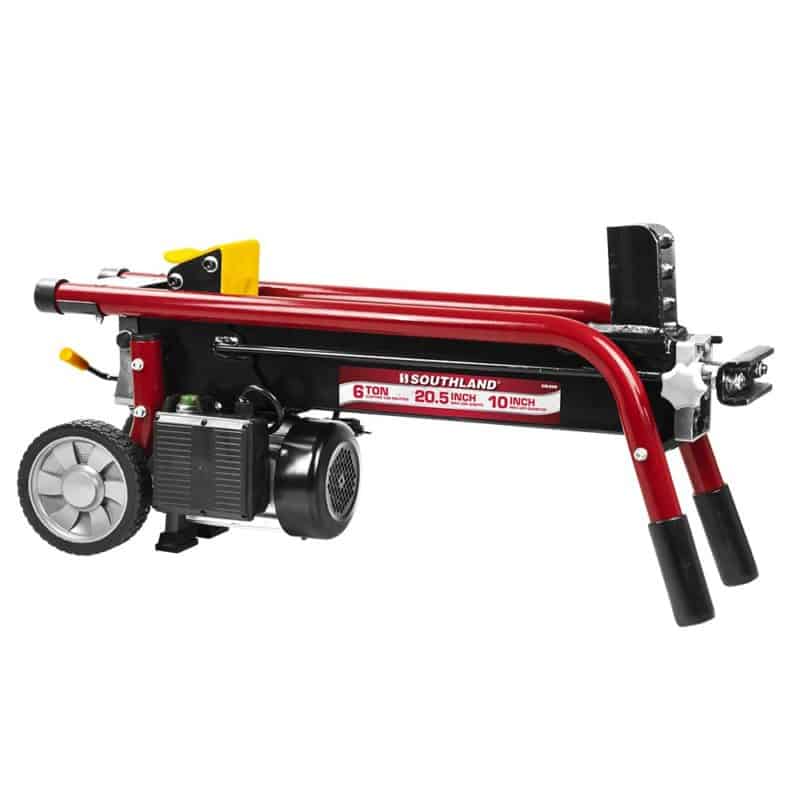
If you are looking for a log splitter that is fast and capable of splitting logs in a short period of time, then the Southland Outdoor Power Equipment Electric Log Splitter is the perfect choice for you. The 1.75 HP 15 Amp engine delivers maximum performance, and the splitter can be operated via an extension cord from your garage or shop’s power source.
A built-in log cradle keeps the logs firmly in position, and the heavy-duty 5-inches steel wedge quickly and easily splits logs up to 20.5-inches in length.
You can use the log splitter safely with the two comfort-grip handles that provide more cutting control. With 7-inches tires, the unit is portable and can be used indoors and outdoors. The splitter is UL-certified and is covered by a 2-year limited warranty.
Pros
- Affordable
- Compact and portable
- Suitable for smaller pieces of wood
- Fast
- Environmentally friendly
Cons
- Not suitable for very big loads
- Not suitable for hardwood or greenwood
2. Boss Industrial Electric Log Splitter
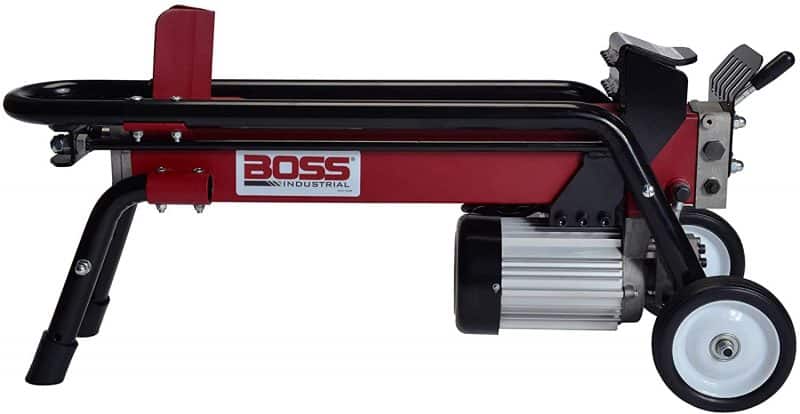
Like its name, the Boss Industrial Electric Log Splitter is powerful and the strong 5-inches steel wedge can split logs up to 20.5-inches in length; and up to 10-inches in diameter, which means it can power through hardwood and greenwood.
The splitter is powered by a 2 HP motor, which is easily started with an electronic push start button. It has a professional-grade hydraulic system, an automatic ram return system, which means it is super fast, and it only requires one hand for full operation.
Pros
- Powerful
- Easy to use
- Great for small to medium jobs
- Portable
Cons
- Noisy
- Slow with large loads
- Can only handle smaller pieces of hardwood
3. Champion Power Equipment Gas Log Splitter

For a durable and efficient log splitter that is capable of handling larger-sized logs, you cannot go past the Champion Power Equipment Gas Log Splitter. Champion Power Equipment’s expertise in making high-quality power equipment that is designed specifically for North American households means you can be assured that this splitter will perform according to industry expectations.
The splitter is powered by an 80 cc single-cylinder 4-stroke OHV engine. It has a 0.4-gallon fuel tank, a 0.4-quart oil capacity, and an automatic low oil shut-off sensor. There is a 20 second ‘no load’ cycle time, an integrated log cradle, and a skewed wedge, which means that the unit is fast and will efficiently turn logs into firewood in a flash. Although it requires a fuel and oil mixture, the splitter is (EPA+CARB certified) in 50 States.
It is lightweight and comes with a convenient handle, and the 10-inches wheels are guaranteed to never go flat, and it can even fit into the boot of your car.
Pros
- Affordable
- Portable
- Small enough to fit into the boot of a car
- Can cut hardwood and logs up to 19-inches
- Low to the ground
Cons
- Requires a mixture of fuel and engine oil
- Short operating handle
4. NorthStar Horizontal/Vertical Log Splitter
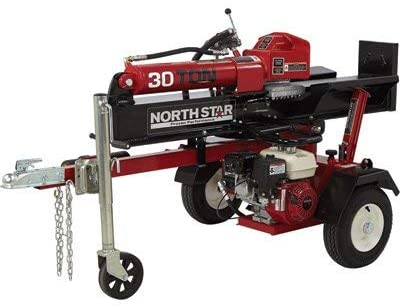
The NorthStar Horizontal/Vertical Log Splitter is designed to work in both a horizontal and vertical position. Its 30-ton capacity means it can split large logs that measure 25 x 16-inches and can easily cut its way through hardwood. It is powered by a strong Honda GX200 cc engine with an auto-idle/throttle control for extended engine life, as well as improved fuel economy and reduced engine noise.
The concentric hydraulic pump is designed to intelligently adjust flow and pressure when cutting through a log, while also increasing your cutting productivity.
Pros
- Powerful
- Large cutting capacity
- Quiet
Cons
- More expensive
- Require tools to assemble the splitter
5. YARDMAX Horizontal/Vertical Log Splitter
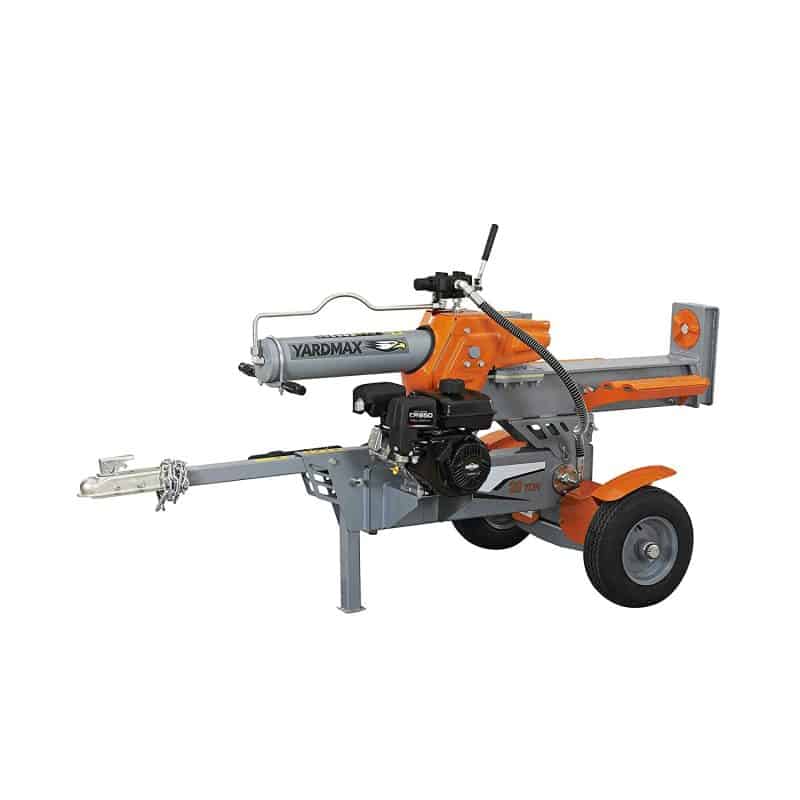
A beast of a machine, the rugged YARDMAX Horizontal/Vertical Log Splitter will help you to cut through a large amount of wood quickly as it has 28-ton of splitting force. This splitter offers you optimal performance due to the extra powerful 6.5 HP Briggs & Stratton engine.
Dual log cradles mean you do not have to constantly bend over to pick up the split logs. Its log spinner foot plate easily rotates those tough-to-split logs during splitting and reduces stress on the beam.
The YARDMAX is easy to assemble and its user-friendly design allows you to split logs safely and effortlessly when loaded from either side of the machine.
Pros
- Heavy-duty rugged design
- Powerful and fast
- Ideal for large loads
Cons
- Expensive
- Heavy to move
6. Sun Joe Hydraulic Log Splitter
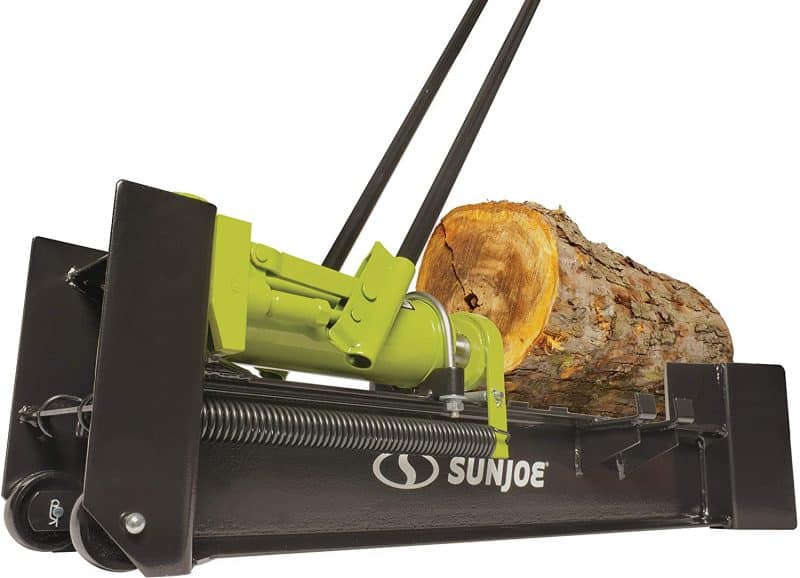
Do not be fooled by the basic design of this manually operated Sun Joe Hydraulic Log Splitter as it is made out of durable steel construction. Although it is made from steel it is still lightweight at 87lbs, which is less than other similar brands,
The compact hydraulic system offers 2-speed variations and can build up to 10-ton of pressure, which is enough to split logs up to 18-inches long and 8-inches wide. The handles on the pump provide for easy manipulation when applying pressure and controlling the splitting of the wood. There is a log cradle, which prevents split wood from falling onto the ground, and the rear wheels provide greater maneuverability.
Pros
- Easy to use
- Suitable for small loads
- Suitable for softwood
- Easy to store
Cons
- Not ideal for large loads
- Not suitable for greenwood or wood over 8-inches in diameter
- Also not very fast
7. Logosol Smart-Splitter Log Splitter

If you do not have the space for a bulky electric or gas log splitter, why not invest in the Logosol Smart-Splitter Log Splitter. The Logosol Firewood Splitter is called a ‘Smart Splitter’ and it is aptly named. It is a brilliantly conceived Swedish Patented Invention which uses gravity, not muscle, and can strike up to 14-ton of pressure at the edge of the blade, and with the guide bar, the weight is directed onto the target every time.
You can split any type of wood irrespective of hardness. It has a 4-in-1 tool setting: axe, splitting axe, splitting hammer, and Wedge. The splitter can be used inside or out, and there is very low maintenance required, as it comes with an all-weather cover for protection against rust.
The setup of the Smart Splitter is easy. All you need is a hardwood stump with a maximum height of 14-inches and a diameter of 14-15-inches. Drill a hole into the stump’s base drill of at least 12cm deep and 8cm from the edge of your base log.
Insert the Smart Splitter into your base and tighten the bolt with a wrench to secure it into the splitting wedge. Lift the handle & place the log to be split under the wedge. And then lift the striking weight with both hands and let gravity do the rest.
Pros
- Affordable
- Economical and convenient
- Suitable for softwood
- Easy to setup
- Ideal for small to medium-sized logs
- Great for kindling wood
- Quiet
Cons
- May require extra swings for hardwood
- Not recommended for damp wood
Our Top Pick for the Best Log Splitter

Our top pick for the best log splitter is the Champion Power Equipment Gas Log Splitter.
It is an efficient log splitter, which is capable of handling larger-sized logs up to 19-inches. It is affordable, fast, and lightweight, which means it can fit into the boot of most vehicles. Although it requires a fuel and oil mixture, the splitter is EPA+CARB certified in 50 States.
Check the price on Amazon